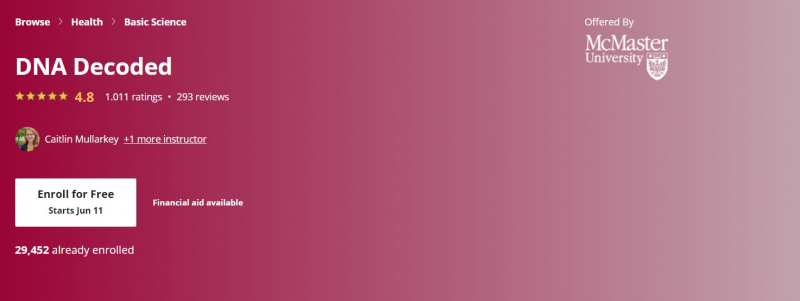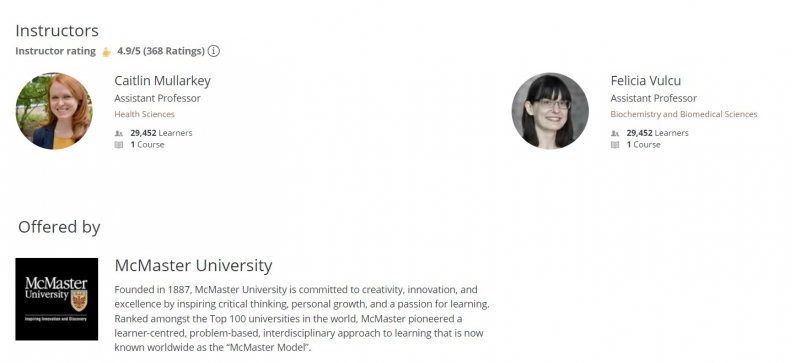DNA Decoded

Why is DNA called the “blueprint of life”? What is a “DNA fingerprint”? How do scientists clone DNA? What can DNA teach you about your family history? Are genetically modified organisms (GMOs) safe? Is it possible to revive dinosaurs by cloning their DNA? DNA Decoded provides solutions to these and other questions. If you're interested in DNA, join Felicia Vulcu and Caitlin Mullarkey, two McMaster University biochemists, as they investigate the structure of DNA, how scientists unlocked the genetic code, and what your DNA may tell them about ourselves. You'll learn about the practical ways that scientists use to examine your genetic risks, change DNA, and find novel therapies for a variety of diseases along the way. Then, enter their virtual lab to conduct your own forensic DNA analysis of crime scene samples and solve a murder.
In this course, you'll learn about how James Watson and Francis Crick were able to solve the riddle of the molecular structure of DNA by building on the work of other scientists. Their groundbreaking discovery revealed that four nucleobases (adenine, thymine, cytosine, and guanine) combine with sugar and phosphate molecules to form the familiar double helix of DNA. You'll take a look at how the molecular structure of DNA regulates its functions; for example, how the chemical bonds (covalent and noncovalent) between these molecules allow DNA to "unzip" during replication.
Then they'll take a look at how you manage to fit over three billion base pairs into each of your cells. You'll explain how RNA copies the genetic information contained in your genes and uses this information to assemble amino acids into proteins. Scientists call this concept the "Central Dogma": DNA makes RNA, and RNA makes protein. You'll also explore how you transmit genetic information from one cell to another—and what happens when things go wrong.
Along the way, you'll learn about techniques (such as polymerase chain reactions and gel electrophoresis) that forensic scientists use in DNA fingerprinting. You'll explore the techniques scientists use to manipulate DNA. Genetic engineering has allowed you to increase crop yields, diagnose illnesses, develop vaccines, and manufacture insulin. By carefully selecting a pair of molecular scissors (restriction enzymes), scientists are able to isolate a gene of interest and insert it into plasmid DNA, turning a common bacteria (E. coli) into a molecular copying machine. In week 4, you'll learn that mutations are genetic errors but that not all mutations are necessarily bad—in fact, some mutations confer a selective advantage that protects against disease. You'll explain what genetically modified organisms are (and what they are not) and weigh in on the heated debates about the ethics and safety of GMOs in the popular media.
What does your DNA say about you? You may have heard that you share 99% of your genetic material with everyone else on the planet. That's true, but this week you're going to take a look at the less than 1% that makes you unique. You'll kick off by discussing the Human Genome Project, the massive scientific collaboration that mapped out the sequence of all your genetic material. The technologies developed while mapping out the human genome ushered in a new age in DNA research. Now, genome-wide association studies can analyze massive amounts of data, searching for genetic variations that are associated with particular diseases. Pharmacogenomics may help determine which drugs are likely to be most effective for you. Genetic genealogy tests (such as Ancestry DNA, 23 and Me, and Family Tree DNA) will allow you to trace random mutations in your DNA that can provide clues to your ethnic heritage. As an added bonus, you'll discuss whether it would be possible to revive extinct species by studying ancient DNA.
This course offers
- Flexible deadlines
- Shareable Certificate
- 100% online
- Intermediate Level
- It takes approximately 23 hours to complete.
- Subtitles: Arabic, French, Portuguese (European), Italian, Vietnamese, German, Russian, English, Spanish
Coursera rating: 4.8/5
Enroll here: https://www.coursera.org/learn/dna-decoded










